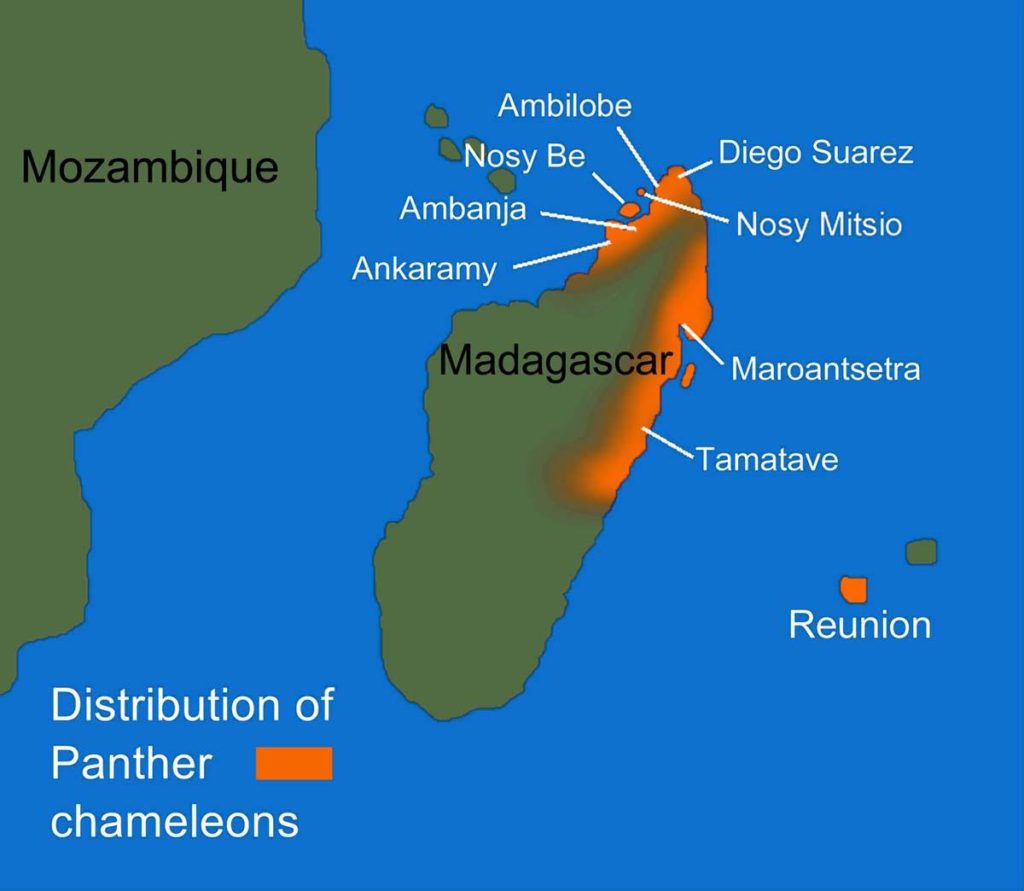Panther chameleons
The Panther chameleon is a firm favourite among chameleons keepers for its size, ease of care but mainly its bright colours.
They come primarily from Madagascar. They live in diverse habitats and a range of locations, giving rise to many colour morphs. Panthers are also found on Reunion and Mauritius.
The male that carries the brightest colours but the females are also pretty in their pink or brown livery, with the orange or black ‘portholes’. As with most chameleons, the male’s colours are at their best confronting a rival or displaying to a female.
The numerous colour variations are just that – variations. They are not species or sub-species. Due to the careless recording of capture data, some Panthers arrive from Madagascar incorrectly named. This is more of a problem with females, which can look remarkably similar even when the males are spectacularly different.

Panther chameleon care
Panthers require the same basic care as Veiled chameleons, such as adequate UV lighting, the correct provision of water, etc.
If you provide these basic requirements, this is an undemanding chameleon. It is often recommended as an ideal first chameleon for the new keeper. A Veiled chameleon may be hardier but the less aggressive disposition of the Panther is in its favour. Unlike Veiled chameleons, I have never seen a Panther chameleon suffering from MBD. However, with improper care it can happen.
Where conditions allow for it, access to unfiltered natural sunlight will improve the health and colour of your chameleon.
Plant the cage with bushy, leafy plants to provide shade and allow for hiding places. Ficus benjamina bushes are good for this, but you can use any leafy non-toxic plant. A cage of 80cm x 80cm x 100cm is adequate.
It is normally not recommended to keep more than one Panther in a cage unless for breeding. Even then, they should be separated soon after or the female may attack the male. Adult males should never be kept together as they are fiercely territorial.
Coming from various parts of Madagascar, they are not restricted to one habitat or ecosystem. This means that they are fairly tolerant with temperature but the following are optimum: daytime between 25°c and 32°c, dropping at night by 5°c or 10°c. Do not let the temperature fall below 14°c or rise much above 32°c; although they may survive they could become stressed.
Vary the diet but crickets are normally the main item. As a Panther gets bigger its appetite drops and fasting for a day or two is not uncommon. Silkworms and grasshoppers make good additions to the diet. Don’t forget vitamin and calcium supplements.
Breeding
A Panther chameleon will breed from about six months but this is too young. Delay mating until she is about one year old, as this will ensure that the female is stronger for egg production.
A receptive female will change colour, becoming peachy or pink. Hold her near the male’s cage to check her response. If she darkens, she is not ready but if she stays lighter coloured, put her in with the male. Watch the male and the female to check that neither is in an aggressive mood.
It is possible to leave the female in the cage with the male if she does not any sign of aggression. They may mate again but be ready to remove her at the first sign of hostility.
Once she has mated, a gravid female will turn darker with black markings. Keep her away from the male while she develops her eggs to avoid stress and be careful of her diet. She will need calcium and good food in the days after mating as she will stop eating up to 10 days before she lays her eggs.
The female will lay about 10 to 30 eggs, although around 20 is average. These may take 10 months or more to hatch. Even eggs from the same batch may not hatch together but emerge over a two month period.
The male may live for 8 years but the female’s life span is reduced due to egg production.

